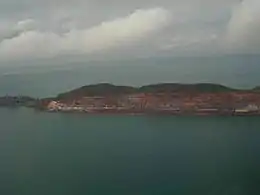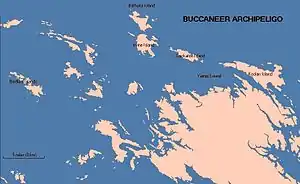Cockatoo Island (Western Australia)
Cockatoo Island is an island in the Buccaneer Archipelago off the coast of Western Australia near the town of Derby. It was mined for iron ore by the Broken Hill Proprietary Company from 1951 until 1984. Koolan Island is a neighbouring island that was also mined by BHP for high grade iron ore. It was most recently mined by Perth-based mining company, Pluton Resources[1] until the company was placed under administration in September 2015.[2]
 Cockatoo Island approached by air from the south-west. The mine working along western edge of the island and the townsite at the northern end (left of photo) are visible. | |
| Geography | |
|---|---|
| Coordinates | 16.0939142°S 123.6091835°E |
| Archipelago | Buccaneer |
| Adjacent bodies of water | Indian Ocean |

History
The ironstone of Cockatoo Island was known to pearl luggers in the 1880s, who used it as ballast on their voyages.[3][4] The Broken Hill Proprietary Company first acquired leases to the island's mineral deposits in 1928, via the company's subsidiary, Australian Iron and Steel Ltd. The island was first surveyed in 1930, then again more comprehensively in 1936. The island was evacuated with the outbreak of World War II and work on the deposit did not resume until 1944.[5]
By October 1945 over 100 men were employed on Cockatoo Island and work was underway laying a foundation for the processing plant, building a jetty and layout the township.[6] Iron ore mining began in 1951.[7] The first shipment of iron ore from the island was made in the vessel Iron Yampi, which was purpose-built at the Whyalla shipyard.[3] It was one of a fleet of four bulk-carriers built to transport the ore for smelting at Australian steelworks. The Iron Kimberley was another of them.[8]
In 1952, the island's population numbered 150.[4] By 1954, the mine was capable of shipping up to 2 million tonnes of iron ore annually.[9] The townsite established by BHP contained a school, movie theatre, and even a lockup prison. BHP continued to operate the mine and manage the township until 1984 when the ore body had been mined down to sea level.
During the 1980s businessman Alan Bond and wife, Eileen Bond, opened a tourist resort using the old mining village's infrastructure.[10][11] The resort was closed and sold to HWE Mining who provided the chalets for their workers to use. HWE Mining and Portman Mining Ltd re-opened operations in the 1990s by first retreating waste-rock from old BHP dumps, then forming a seawall and commencing mining below sea level.
In the 21st century, Perth-based company Pluton Resources mined there, until the company entered administration in September 2015.[2]
References
- "Cockatoo Island Iron Ore Mining". PDF. Watpac. 2014. Retrieved 14 February 2016.
- "Summary of Pluton Resources Ltd (Receiver and Manager Appointed) | The Supreme Court of Victoria". www.supremecourt.vic.gov.au. Retrieved 6 June 2020.
- "YAMPI SOUND TO CHALLENGE WHYALLA Special Freighters Being Built To Carry Iron Ore". Toodyay Herald. 20 June 1947. p. 9. Retrieved 18 December 2015.
- "(ADVERTISEMENT) PEARLERS ONCE USED YAMPI'S IRON ORE FOR BALLAST". The West Australian. 4 November 1952. p. 28. Retrieved 18 December 2015.
- "Busy Community Established On Cockatoo Island". The West Australian. 11 March 1952. p. 3. Retrieved 18 December 2015.
- "BHP To Spend A Million On Yampi". The Daily News. 13 October 1945. p. 1. Retrieved 18 December 2015.
- "Iron ore in Western Australia" (PDF). PDF. Department of Industry and Resources. 1995. Archived from the original (PDF) on 1 September 2007. Retrieved 14 February 2008.
- "ORE SHIP'S LAUNCHING". The West Australian. 6 April 1949. p. 19. Retrieved 18 December 2015.
- ""Staggering" Expansion Of Australia's Steel Industry". The West Australian. 26 November 1954. p. 2. Retrieved 18 December 2015.
- "Alan Bond's tourist resort on Cockatoo Island closed down". Sunday Times (Perth, W.A.). 4 March 1990. p. 10.
- Trott, Peter (26 November 1984). "Cockatoo Island closes down as iron ore producer but could become major tourist attraction". The West Australian. p. 13a-e.